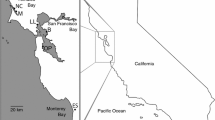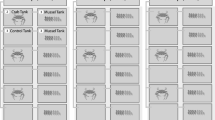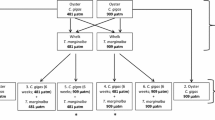Abstract
The response of the eastern oyster C. virginica to the presence of the oyster drill Urosalpinx cinerea was examined from July to September 2011. Several aspects of oyster growth were measured, including wet weight, shell weight, and dorsal shell area for oysters collected near Groton, Connecticut (41.32036 N, −72.06330 W). Wet weight and shell weight growth were significantly higher in the presence of the predator U. cinerea, while tissue weight showed no difference from the control. The control group showed more shell area growth and a much lower ratio of shell weight growth to shell area growth. Differences in shell weight to area ratio indicated that C. virginica dramatically shifted from lateral shell growth to shell thickening in the presence of U. cinerea. This inducible defense has not been previously shown for C. virginica and could play an important role in the predator–prey interaction between these two species.



Similar content being viewed by others
References
Appleton RD, Palmer AR (1988) Water-borne stimuli released by predatory crabs and damaged prey induce more predator-resistant shells in a marine gastropod. Proc Natl Acad Sci USA 85:4387–4391
Arendt JD (1997) Adaptive intrinsic growth rates: an integration across taxa. Q Rev Biol 72:149–177
Bourdeau PE (2010) An inducible morphological defence is a passive by-product of behaviour in a marine snail. Proc R Soc B 277:455–462
Buhle ER, Ruesink JL (2009) Impacts of invasive oyster drills on olympia oyster (Ostrea lurida Carpenter 1864) recovery in Willapa Bay, Washington, United States. J Shell Res 28:87–96
Carriker MR (1969) Excavation of boreholes by the gastropod, Urosalpinx: an analysis by light and scanning electron microscopy. Am Zool 9(3):917–933
Cronin G, Hay ME (1996) Induction of seaweed chemical defenses by amphipod grazing. Ecology 77:2287–2301
Dame RF (1972) The ecological energies of growth, respiration and assimilation in the intertidal American oyster Crassostrea virginica. Mar Biol 17:243–250
Dittman DE, Ford SE, Haskin HH (1998) Growth patterns in oysters, Crassostrea virginica, from different estuaries. Mar Biol 132:461–469
Faasse M, Ligthart M (2009) American (Urosalpinx cinerea) and Japanese oyster drill (Ocinebrellus inornatus) (Gastropoda:Muricidae) flourish near shellfish culture plots in the Netherlands. Aquat Invasions 4:321–326
Federighi H (1931) Studies on the oyster drill (Urosalpinx cinerea Say). Bull US Bur Fish 47:83–115
Franz DR (1971) Population age structure, growth and longevity of the marine gastropod Urosalpinx cinerea Say. Bio Bull 140:63–72
Gazeau F, Gattuso JP, Dawber C, Pronker AE, Peene F, Peene J, Heip CHR, Middelburg JJ (2010) Effect of ocean acidification on the early life stages of the blue mussel Mytilus edulis. Biogeosciences 7:2051–2060
Graus RR (1974) Latitudinal trends in the shell characteristics of marine gastropods. Lethaia 7:303–314
Hanks JE (1957) The rate of feeding of the common oyster drill, Urosalpinx cinerea (Say), at controlled water temperatures. Bio Bull 112(3):330–335
Harvell CD (1986) The ecology and evolution of inducible defenses in a marine bryozoan: cues, costs, and consequences. Am Nat 128(6):810–823
Karban R, Myers JH (1989) Induced plant responses to herbivory. Ann Rev Ecol Syst 20:331–348
Kawai K (2009) Shell growth, reproduction and mortality of Ovula ovum in southern Kyushu, Japan. J Moll Stud 75:35–40
Leonard GH, Bertness MD, Yund PO (1999) Crab predation, waterborne cues, and inducible defenses in the blue mussel, Mytilus edulis. Ecology 80(1):1–14
Lively CM (1986) Predator-induced shell dimorphism in the acorn barnacle Chthamalus anisopoma. Evolution 40:232–242
McIntosh AR, Townsend CR (1996) Interactions between fish, grazing invertebrates and algae in a New Zealand stream: a trophic cascade mediated by fish-induced changes to grazer behaviour? Oecologia 108(1):174–181
Miyaji T, Tanabe K, Matsushima Y, Sato S, Yokoyama Y, Matsuzaki H (2010) Response of daily and annual shell growth patterns of the intertidal bivalve Phacosoma japonicum to Holocene coastal climate change in Japan. Palaeogeogr Palaeocl 286:107–120
Nakaoka M (2000) Nonlethal effects of predators on prey populations: predator-mediated change in bivalve growth. Ecology 81(4):1031–1045
Newell RC, Kofoed LH (1977) Adjustment of the components of energy balance in the gastropod Crepidula fornicata in response to thermal acclimation. Mar Biol 44:275–286
Ordzie CJ, Garofalo GC (1980) Predation, attack success, and attraction to the bay scallop, Argopecten irradians (Lamarck) by the oyster drill, Urosalpinx cinerea (Say). J Exp Mar Biol Ecol 47(1):95–100
Palmer AR (1982) Growth in marine gastropods: a non-destructive technique for independently measuring shell and body weight. Malacologia 23:63–73
Palmer AR (1985) The adaptive value of shell variation in Thais lamellosa: effect of thick shells on vulnerability to prey and to preferences by crabs. Veliger 27:349–356
Palmer AR, Carriker MR (1979) Effects of cultural conditions on morphology of the shell of the oyster. Proc Natl Shellfish Assoc 69:58–72
Peacor SD, Werner EE (2001) The contribution of trait-mediated indirect effects to the net effects of a predator. Proc Natl Acad Sci 98(7):3904–3908
Peters RH (1983) The ecological implications of body size. Cambridge University Press, New York
Polson MP, Hewson WE, Eernisse DJ, Baker PK, Zacherl DC (2009) You say conchaphila, I say lurida: molecular evidence for restricting the Olympia oyster (Ostrea lurida Carpenter 1864) to temperature western North America. J Shell Res 28:11–21
Pratt DM (1974) Behavioral defenses of Crepidula fornicata against attack by Urosalpinx cinerea. Mar Biol 27:47–49
Ren JS, Ross AH (2001) A dynamic energy budget model of the Pacific oyster Crassostrea gigas. Ecol Model 142:105–120
Schmitz OJ, Beckerman AP, O’Brien KM (1997) Behaviorally mediated trophic cascades: effects of predation risk on food web interactions. Ecology 78(5):1388–1399
Sebens KP (1987) The ecology of indeterminate growth in animals. Ann Rev Ecol Syst 18:371–401
Singh SM, Zouros E (1978) Genetic variation associated with growth rate in the American oyster (Crassostrea virginica). Evolution 32(2):342–353
Thomsen J, Melzner F (2010) Moderate seawater acidification does not elicit long-term metabolic depression in the blue mussel Mytilus edulis. Mar Biol 157:2667–2676
Trussell GC, Etter RJ (2001) Integrating genetic and environmental forces that shape the evolution of geographic variation in a marine snail. Genetica 112–113:321–337
Trussell GC, Ewanchuk PJ, Bertness MD (2003) Trait-mediated effects in rocky intertidal food chains: predator risk cues alter prey feeding rates. Ecology 84(3):629–640
Turner AM, Bernot RJ, Boes CM (2000) Chemical cue modify species interactions: the ecological consequences of predator avoidance by freshwater snails. Oikos 88(1):148–158
Underwood AJ (1997) Experiments in ecology: their logical design and interpretation using analysis of variance. University Press, Cambridge
Van Alstyne KL (1988) Herbivore grazing increases poly-phenolic defenses in an intertidal brown alga, Fucus distichus. Ecology 69:655–663
Vermeij GJ (1982) Phenotypic evolution in a poorly dispersing snail after arrival of a predator. Nature 299:349–350
Acknowledgments
Thanks to Jeremy Calini and Wendy Turek, who were instrumental in the design, setup, and execution of this experiment. Additional thanks to Zair Burris for assistance with pre-experimental measurements. The project was funded by grants from the Connecticut College Sea Grant and U.S. EPA—STAR programs.
Author information
Authors and Affiliations
Corresponding author
Additional information
Communicated by S. Connell.
Rights and permissions
About this article
Cite this article
Lord, J.P., Whitlatch, R.B. Inducible defenses in the eastern oyster Crassostrea virginica Gmelin in response to the presence of the predatory oyster drill Urosalpinx cinerea Say in Long Island Sound. Mar Biol 159, 1177–1182 (2012). https://doi.org/10.1007/s00227-012-1896-7
Received:
Accepted:
Published:
Issue Date:
DOI: https://doi.org/10.1007/s00227-012-1896-7




